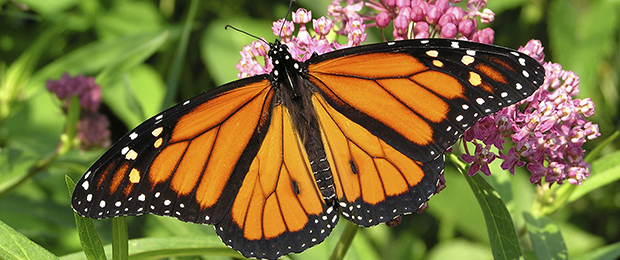RE-WRITTEN and UPDATED
If there were a contest to name the most-hated chemical, Roundup, the brand name for the chemical glyphosate, would have a very good chance of winning. It has been identified as not only a plant poison, but also a destroyer of monarch butterflies, an impoverisher of developing-world farmers, and a probable carcinogen. These are serious issues. But they are also complex, and not completely settled (except for it being a plant poison). On the other hand, there is a different, large, and growing problem in Roundup-dependent agriculture.
The Butterfly Effect
One of the environmentally damaging effects ascribed to Roundup is the decline of monarch butterflies. There really is a connection between Roundup and the beautiful monarch butterfly, but it’s not as usually described.
North American monarch butterflies are an incredible species. The annual life cycle of those that migrate (many do not) goes like this. In the winter, they are in an altered metabolic state, called diapause, which resembles hibernation. Many of them are gathered in massive clusters in high mountainous regions of Mexico. The total number of butterflies in Mexico (a smaller number spend the winter in southern California) was in the hundreds of millions in the winter of 2024-25, but it fluctuates year by year, and is now generally lower than historically. In 2023-2024, there were estimated to be half as many as in 2024-25.

Early in Spring, they awaken in response to environmental signals and begin a journey of several months’ duration, thousands of kilometers northward, reaching ultimately into Canada. But they are not at the end of the migration. In March and April they mate and lay eggs on milkweed plants and die. The newly hatched caterpillars eat the milkweed, and undergo transformation within a chrysalis, to emerge as the beautiful monarch we see in the garden. They are the first generation of the new year.
This generation continues the northward migration, but it needs to act quickly; it will live for only a few weeks, and during this time it must produce the next generation. The eggs it lays will hatch in May and June to produce the year’s second generation. These insects repeat the process to produce the third, which begets the fourth. The year’s first, second, and third generations live for only a few weeks or months. But the fourth, miraculously, lives long enough to migrate to Mexico, overwinter, and begin the cycle again the next Spring.
It is the great-great-grandchildren of the butterflies that left the overwintering sites who return to them. How do they know where to go? Some scientists think there is a sensory organ that can read the earth’s magnetic field, and allow navigation by it. But our understanding is limited. What’s clear is that the monarchs have a genetically-determined ability to carry out that multi-generational migration.
As I’ve said, the numbers of overwintering butterflies in Mexico is on a downslope historically. Survival of the species is a concern. There are several causes of this decline. One of them is the loss of milkweed, which they depend on. Researchers have found that in the American midwest, there are far fewer milkweeds in farmers’ fields than there used to be, and correspondingly fewer butterfly eggs. The combination of fewer milkweed plants and fewer eggs per plant leads them to an estimation of an 81% decline in monarch production in the Midwest from 1999 to 2010, which happens to correspond to the reduction in the number of overwintering butterflies in Mexico during that time.
Commonly discussed threats to monarch butterflies include the degradation of the overwintering grounds in Mexico (illegal deforestation), climate change (premature warming throws them off their migration cycle), and the use of Roundup on American farms. The last of these is linked to the development of Roundup-resistant crops such as corn and soybeans. Such genetically-engineered (GMO) crops are sprayed with Roundup to kill weeds, including milkweed, to reduce the cost of production.
The reduction in milkweed is also a result of a reduction in ‘waste’ agricultural land — ditches and margins that have been turned into cropland, largely eliminating milkweed production.
Roundup and cancer
Is glyphosate a carcinogen — does it cause cancer? A report in 2000 claimed that it doesn’t. That paper; however, has been retracted (in 1925) by the journal it was originally published in. Problems included that much of the data in it came from unpublished Monsanto results, that Monsanto scientists had a heavy (and unacknowledged) hand in writing the paper, and, incredibly, that its authors may have been paid by Monsanto (the suppliers of glyphosate at the time). Any of these conditions would be enough to invalidate the veracity of the paper.
The linkage between Roundup and cancer was strengthened by a report in 2015 from the International Agency for Research on Cancer (IARC), a semi-autonomous arm of the World Health Organization. That study placed glyphosate, the generic name of Roundup, into the category of ‘probable human carcinogen’. This result, which was reported in just about every news outlet in the world, has had a profound effect on people’s thoughts about the safety of Roundup. It suggested that farmers, applicators, casual users, and handlers were at significant increased risk of getting cancer.
The mandate of IARC is to examine the literature to see if there is a linkage between agents and activities and cancer (it doesn’t carry out research itself). It tries to determine ‘hazard’, any possible connection, whether supported by data on humans or laboratory animals. It does not establish human ‘risk’, that is, the likelihood that people will get cancer (which depends on hazard, exposure time, and dose).
In reviewing the world literature on glyphosate, the IARC found some data that suggested a possible cancer risk in laboratory animals exposed to high levels of glyphosate, but very little data that pointed to a human risk. But a very recent study suggests that there is a cancer risk from glyphosate in rats at the low levels normally considered to be safe (1).
The existence of a glyphosate-cancer link is unsettled. Even the editor who withdrew the discredited 2000 paper that claimed there was no such link stated that linkage is not yet established. One of the few types of human studies that tests linkage is to look for an increased cancer incidence is herbicide applicators, men (mostly men) who mix and apply glyphosate in agriculture, and who are thereby exposed to high levels of it. The data available today suggest that herbicide applicators who are exposed to glyphosate are not at an increased risk of cancer (2). That study concluded: “This updated meta-analysis reinforces our previous conclusion of a lack of an association between exposure to glyphosate and risk of NHL (non-Hodgkins lymphoma, the cancer most usually associated with glyphosate) . . . .” (Incidentally, AI is pretty good on this topic.)
For their part, the U.S. Environmental Protection Agency, the European Food Safety Authority, Health Canada’s Pest Management Regulatory Agency, New Zealand’s Environmental Protection Authority and Japan’s Food Safety Commission have all concluded that glyphosphate is unlikely to cause cancer in humans. In 2016, a meeting of the Food and Agriculture Organization (of the UN) concluded the same thing. But these evaluations are due for reconsideration; the EPA is mandated to re-evaluate the safety of glyphosate in 2026.
Roundup’s existential problem
Roundup may yet have a lot to answer for in the decline of the migrating monarch butterfly population, although farming practices that maximize the portion of the land under cultivation must bear at least some of the blame. And glyphosate may yet turn out to be carcinogenic for humans, although the available evidence strongly suggests it isn’t. But there is a fundamental problem for the continued use, and usefulness, of glyphosate/Roundup: before long, there will be so much resistance to it in the world of weeds that it no longer has any beneficial effect.
A genetic mutation is responsible for the glyphosate resistance of GMO plants genetically engineered for it. That gene came, not from a plant, but from bacteria selected for resistance. Bacteria are like plants in that they need to synthesize their so-called aromatic amino acids (tyrosine, phenylalanine and tryptophan). Humans get these amino acids from the protein they eat (ultimately, from plants). Glyphosate inhibits just one enzyme on the pathway for aromatic amino acid synthesis, EPSP synthase. But that inhibition stops the growth of any plant, and it will die, which is why Roundup is such an effective weed killer. Bacteria with the right mutation in EPSP synthase can grow in the presence of Roundup, and that mutated gene was engineered into a variety of food plants back in the 1990s. This made these cultivars resistant to Roundup, and Monsanto started making a lot of money from them. The fact that the target of glyphosate is an enzyme that is not present in animals makes it a very specific growth inhibitor.
But evolution never rests. Genetic variations arise all the time. Glyphosate-resistant ‘somaclonal variations’ in maize (corn) were discovered in 1995, and similar mutations exist in cotton. No genetic engineering was required; these variations in the EPSP synthase enzyme occurred spontaneously. It was inevitable that some weeds, somewhere, would develop the same mutation, and this has, indeed, happened. Such weeds are not affected by glyphosate and have been selected for by glyphosate in their environment.
Glyphosate-resistant “superweeds” are becoming a bigger problem all the time. They have led to the use of increasing levels of glyphosate (250 million pounds of Roundup were sprayed on crops in the USA in 2012). Glyphosate-resistant weeds were essentially unknown before the introduction of Roundup-resistant crops in 1996, but now infect somewhere around 50 million hectares (nearly 125 million acres) in the United States alone. It is this practical outcome which will ultimately limit to its use.
Like the overuse of antibiotics, which has led to drug resistant pathogenic bacteria becoming a major health hazard, overuse of glyphosate has led us to the present condition. Roundup may have only a limited lifetime of usefulness, before careful, organic methods of farming will be the only way to continue.
Work Cited
- Panzacchi S et al., Carcinogenic effects of long-term exposure from prenatal life to glyphosate and glyphosate-based herbicides in Sprague-Dawley rats. Environ Health. 2025 Jun 10;24:36.
- Boffetta, P., Ciocan, C., and Zunarelli, C., Exposure to glyphosate and risk of non-Hodgkin lymphoma: an updated meta-analysis, La Medina del Lavoro, 112(3) 11123, 2021.





Great read authored by a favourite professor of mine at UVic.